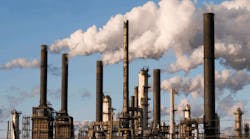EPA: Air Emissions of Toxic Chemicals from Industrial Facilities Down More Than Half Since 2005
EPA released its annual Toxics Release Inventory (TRI) National Analysis, which offers some good news about air quality in the United States. According to the TRI National Analysis, releases of toxic chemicals into the air fell 56 percent from 2005 to 2015 at industrial facilities submitting data to the TRI program, and it showed an 8 percent decrease from 2014 to 2015.
“[This] report shows action by EPA, state and tribal regulators and the regulated community has helped dramatically lower toxic air emissions over the past 10 years,” said Jim Jones, EPA assistant administrator for the Office of Chemical Safety and Pollution Prevention. “The TRI report provides citizens access to information about what toxic chemicals are being released in their neighborhoods and what companies are doing to prevent pollution.”
Hydrochloric acid, sulfuric acid, toluene and mercury were among chemicals with significantly lower air releases at TRI-covered facilities. Medical professionals have associated these toxic air pollutants with health effects that include damage to developing nervous systems and respiratory irritation.
Combined hydrochloric acid and sulfuric acid air releases fell more than 566 million pounds, mercury more than 76,000 pounds and toluene more than 32 million pounds at TRI-covered facilities. Coal- and oil-fired electric utilities accounted for more than 90 percent of nationwide reductions in air releases of hydrochloric acid, sulfuric acid and mercury from 2005 to 2015 in facilities reporting to the program.
In 2015, of the nearly 26 billion pounds of total chemical waste managed at TRI-covered industrial facilities (excluding metal mines), approximately 92 percent was not released into the environment due to the use of preferred waste management practices such as recycling, energy recovery and treatment. This calculation does not include the metal mining sector, which presents only limited opportunities for pollution prevention. The TRI Pollution Prevention (P2) Search Tool has more information about how individual facilities and parent companies are managing waste and reducing pollution at the source.
EPA, states and tribes receive TRI data annually from facilities in industry sectors such as manufacturing, metal mining, electric utilities, and commercial hazardous waste management. Under the Emergency Planning and Community Right-to-Know Act (EPCRA), facilities must report their toxic chemical releases for the prior calendar year to EPA by July 1 of each year. The Pollution Prevention Act also requires facilities to submit information on pollution prevention and other waste management activities of TRI chemicals. Nearly 22,000 facilities submitted TRI data for calendar year 2015.
This year’s report also includes a section highlighting the new Frank R. Lautenberg Chemical Safety for the 21st Century Act. This section focuses on the overlap between TRI chemicals and chemicals designated as Work Plan chemicals by EPA’s Office of Chemical Safety and Pollution Prevention under the Toxic Substances Control Act (TSCA).
The TRI National Analysis website includes new interactive features such as an automated “flipbook” depicting how the TRI Program has evolved over the past 30 years, and a new embedded dashboard that allows users to build customized visualizations of TRI data by a chemical or a sector.

